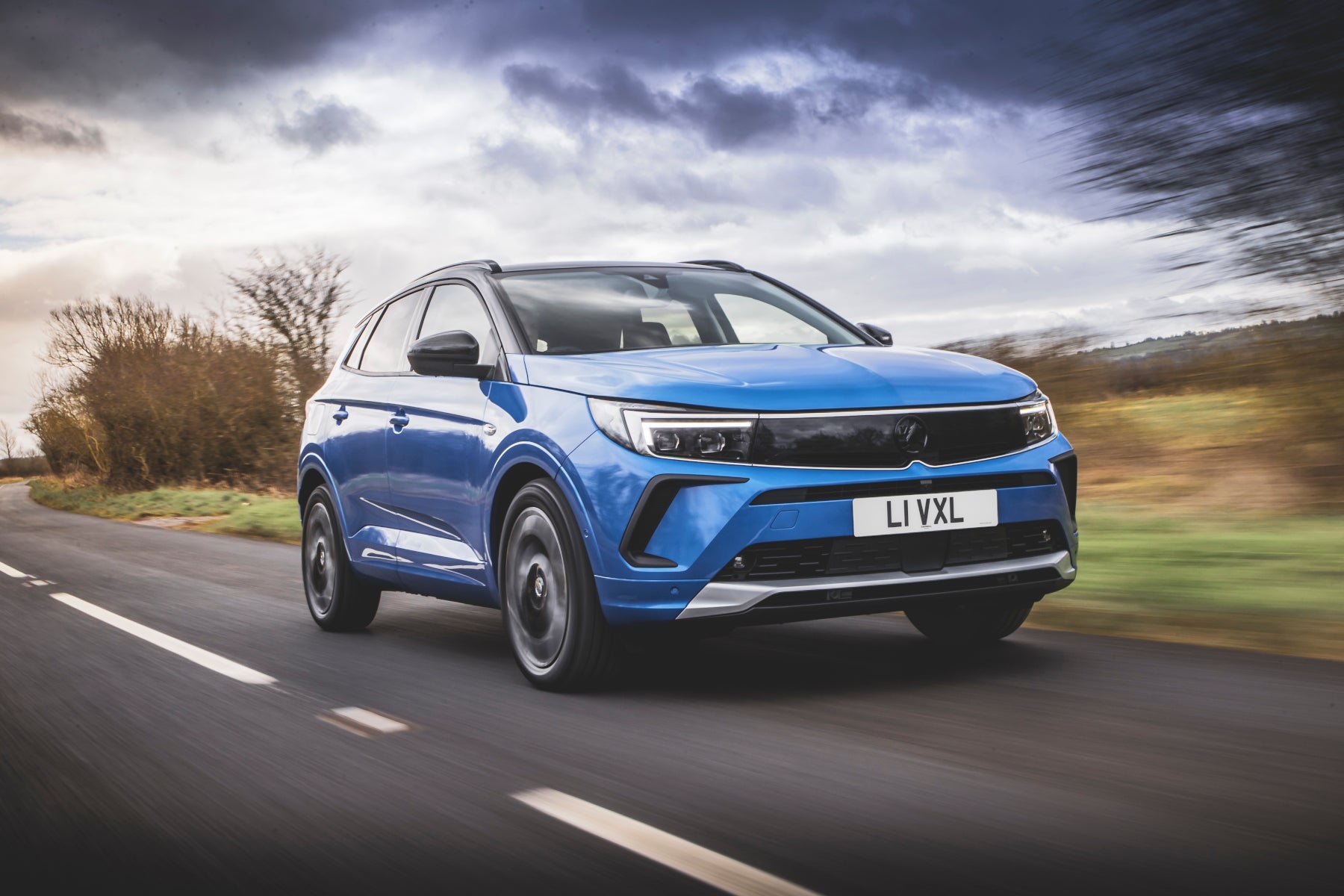Vauxhall Grandland (2022-2024) Review
Written by Lawrence Allan
Quick overview
Pros
- Practical, kit-laden interior
- Comfortable and refined
- 2022 facelift is a lot less bland
Cons
- Still not exactly exciting
- There are sharper handling SUVs
- Simplified trim range has removed some key kit
Overall verdict on the Vauxhall Grandland
"The Grandland X is now simply the Grandland. With a much improved exterior design, nicer interior with better tech and a decent all-round driving experience, it's more competitive. It's also pretty affordable."
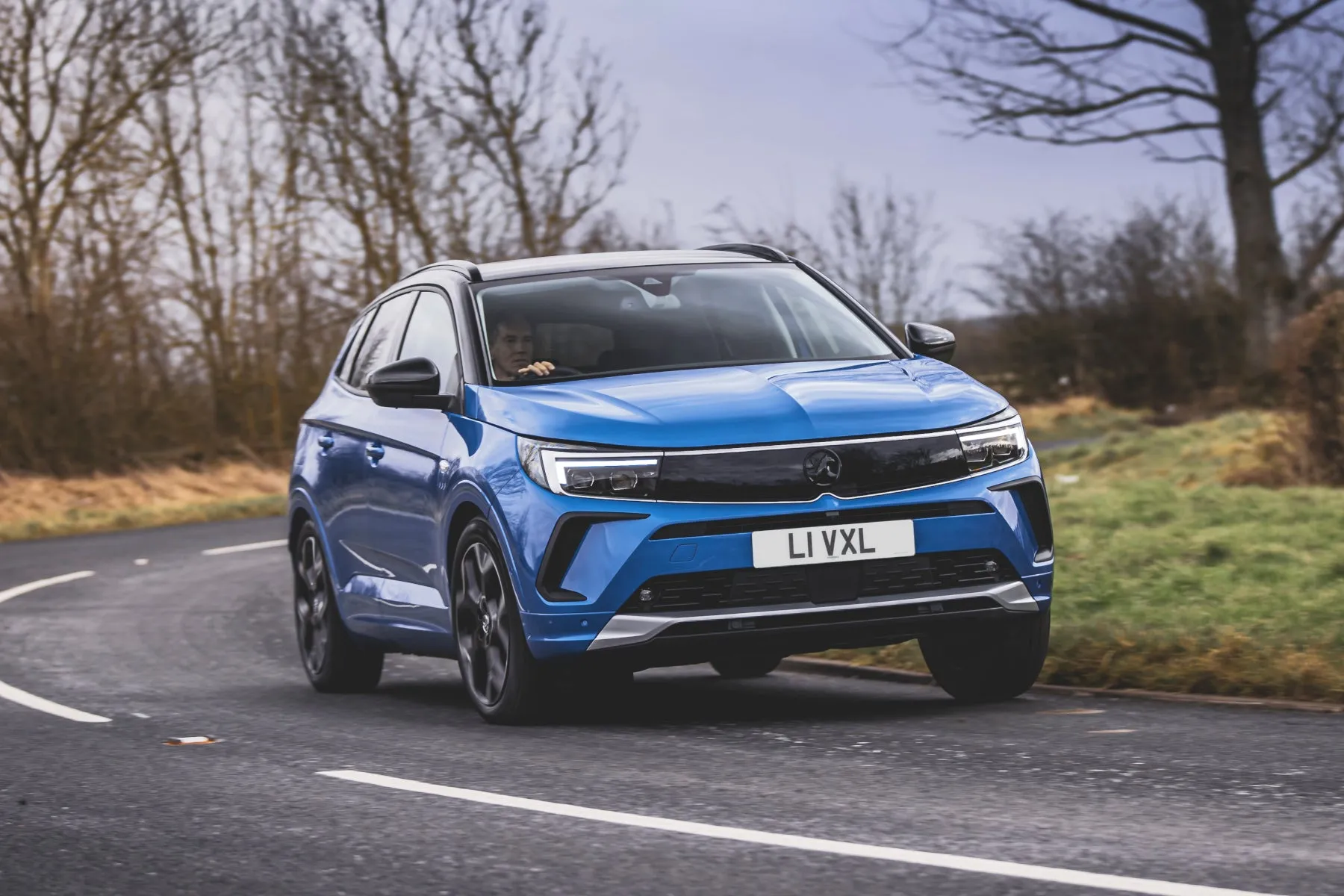
The Vauxhall Grandland proves that not every car needs to dazzle you with a bold design, a bewildering array of technology and sports car-like handling. Sometimes you just want an affordable car that ticks all the rational boxes. In this Vauxhall Grandland review, however, we'll see if the refreshed family SUV has more showroom appeal than before.
What's happened to the 'X' previously in the name? Well, in 2022, the Vauxhall formerly known as the Grandland X followed the smaller Crossland and Mokka in ditching it in an effort to broaden the car's appeal. But Vauxhall did much more than that: for starters, the Grandland is noticeably more visually appealing. Which isn't hard, because the old car was as stylish as that dusty anorak in the back of your wardrobe.
Granted, it still won't make your neighbours' curtains twitch in the same way that its Hyundai Tucson or (closely related) Peugeot 3008 rivals might, nor does it have the premium air of the Volkswagen Tiguan, But its sharp 'Vauxhall Vizor' face (inspired by the distinctive Mokka) tweaked rear-end and two-tone roof and body colours on most variants make it a fair bit less dreary to behold.
Step inside and, while it's not exactly colourful or elegant, fresh upholstery and a twin-screen infotainment and digital dial setup on most models helps modernise things. Quality is generally pretty good, while the rational approach means that the layout is more intuitive to operate than its more eccentric 3008 cousin. The Skoda Karoq and SEAT Ateca have even easier-to-use interiors, however.
The old Grandland X was never particularly dazzling in terms of its technology, so the facelifted car brings a few new additions. Highway Integration Assist allows the car to steer, centre itself in the lane, brake and accelerate largely by itself even in slow traffic, while new 'Intellilux LED Pixel' adaptive headlights (standard on top spec) have 84 LEDs per headlight and multiple modes depending on conditions. There's even a night vision system on the options list, which displays in the digital dials and highlights potential hazards well before you'll see them.
Like the Peugeot, the Vauxhall has plenty of space for you and another tall adult to get comfortable in the front, while leaving plenty of room for a pair of towering specimens in the back. Even three-up, adults won't feel terribly squashed. The boot is large and practical, too, and you get plenty of smaller storage spaces scattered about the place.
It's not just the interior space that makes the Vauxhall Grandland an ideal family car, it's also very comfortable. It might not have the fancy air suspension option of a premium SUV but the Grandland glides over the majority of bumps like they're not there and the cabin is quiet at speed. Seats designed for long-distance ergonomics mean it's a great long-distance cruiser, as does standard adaptive cruise control and lane positioning assist on all but the base model.
Thankfully, the Vauxhall Grandland's comfort doesn't come at the expense of turning it into a blancmange in corners. It doesn't roll excessively and the accurate steering inspires confidence on the move. Yes, there are sharper and more entertaining SUVs out there, but many of those are firmer riding.
These well-rounded road manners are a brilliant match for the Vauxhall Grandland's excellent 130PS 1.2-litre PureTech turbo petrol engine. It sounds worryingly small in a car this size, but you'll soon forget about its capacity when you sample its surprising punch and smooth delivery. Only when you're pulling away from the lights or overtaking in the wrong gear can it occasionally bog down while you wait for the turbo's slug of torque.
It's such a well-rounded engine that the 130PS diesel only makes sense if you spend most of your life on the motorway. Meanwhile, the 225PS plug-in hybrid will appeal to business users because of its low benefit-in-kind tax, and isn't too overpriced for the private buyer. A 39-mile electric range is useful, but the PHEV makes less sense if you're not able to plug it in at home or at your destination. The sporty GSe model uses an uprated 300PS version of this same PHEV powertrain, but it doesn't feel a whole lot sportier in truth.
Looking for a used car for sale? We've got 100s of Vauxhall Approved Used Cars for Sale for you to choose from, including a wide range of Vauxhall Grandland cars for sale. If you're looking for the newer version, you need our Vauxhall Grandland review, while there's also our Vauxhall Grandland Electric review.
Is the Vauxhall Grandland right for you?
The Vauxhall Grandland is right for you if you're looking for a spacious, well-rounded family car that goes about its business without drawing attention to itself. A facelift means it's no longer boring to look at, and while some rival SUVs have gone down the divisive design route, the Vauxhall treads a smart and sensible path.
With petrol, diesel and plug-in hybrid engine options, there’s something to suit most requirements. It’s also comfort-focused (more important in a car of this type than razor-sharp handling) and looks like decent value next to increasingly expensive competition.
What's the best Vauxhall Grandland model/engine to choose?
The Vauxhall Grandland is seen in its best light when fitted with a 130PS PureTech petrol engine, which delivers pretty strong performance – considering its tiny 1.2-litre capacity – and excellent fuel economy. Combined with a low list price, you should really question if you need the extra performance of the pricier plug-in hybrid.
In the transformation from Grandland X to Grandland in 2022, the rather bewildering range of trims was reduced to just three, but these have changed a little bit since. Even base Design model is well-equipped, but misses out on the larger infotainment screens, adaptive cruise control and contrasting roof option. It also misses out on roof rails, and we reckon SUVs always look a bit dowdy without them. Mid-spec GS or GS Line are probably the best compromise between cost and kit.
What other cars are similar to the Vauxhall Grandland?
You have a huge choice if you're looking for a mid-sized SUV. The mechanically very similar Peugeot 3008 is clearly a more overtly stylish offering than the Grandland, while Volkswagen Group SUVs – the classy Volkswagen Tiguan, Skoda Karoq and SEAT Ateca – are excellent all-rounders. We'd also suggest looking at the refined Ford Kuga, and if it's hybrid power you want, the Toyota RAV4 and Honda CR-V both excel.
Other models worth considering include the Kia Sportage and Hyundai Tucson, both of which have long warranties and a reputation for reliability, plus the popular Nissan Qashqai.
Comfort and design: Vauxhall Grandland X interior
"The Vauxhall Grandland is a lot more conventional-looking inside than the Peugeot 3008. It's a bit dull, perhaps, but the quality is pretty good."
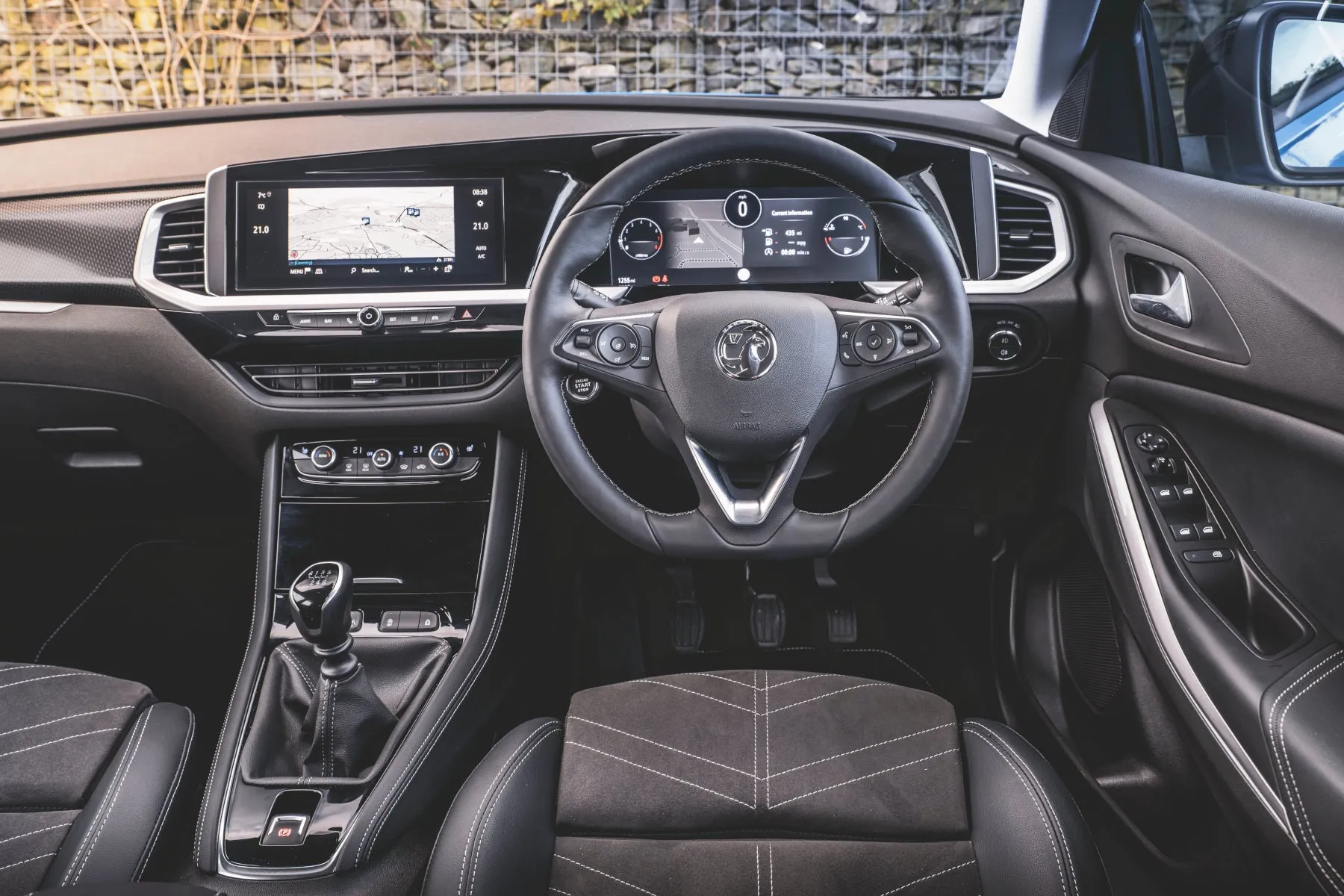
Inside, the Vauxhall Grandland is the chalk to the Peugeot 3008's cheese. Like the outside, both platform-sharing models look very different inside, and it's clear that the Peugeot is the one that'll wow people in the showroom.
Look past the lack of excitement, however, and the Grandland's simpler, more user-friendly layout means it's appeal goes beyond glitz and glamour. Despite the bigger touchscreen, many physical buttons are retained, meaning tasks such as turning off lane keep assist, changing the fan speed and switching drive modes doesn't involve fiddling with the screen.
Fundamentally the Grandland's dashboard architecture is the same as the old Grandland X's, but the key difference is the twin-screen infotainment and dial design. It's best appreciated on GS or GS Line trim and above where both screens are larger.
Most of the things you poke and prod feel of decent quality, while storage is pretty good (apart from the tiny glovebox). There are some harder, shinier plastics, however. Mid-spec models and above get an ergonomically designed driver's seat said to be better for your back over long distances, although you only get the same for your front passenger if you step up to the top trim.
Quality and finish
Build quality is decent enough in the Vauxhall Grandland. The majority of the dashboard is made from spongy plastics that feel dense and expensive, and the tops of the doors are made from the same stuff.
It's not quite a clean sweep: the stalks behind the steering wheel don't work with the same oily damping of a Volkswagen Group car and there are some harder, shinier plastics dotted about the place. We're also not especially keen on the mass of gloss black trim on the dash, which is something the new Astra is similarly afflicted by.
Still, the half-leather trim on higher end models feels of good quality, with Alcantara centres and nice stitching, and we didn't experience any major rattles or creaks on our test drive. Overall, it's apparent that the Grandland is one of the more affordable family SUVs in the Stellantis stable, but you're not constantly reminded of that.
Infotainment: Touchscreen, USB, nav and stereo in the Vauxhall Grandland
The old Vauxhall Grandland X came with an entirely acceptable infotainment setup, which comprised of a 7.0-inch screen on cheaper models and an 8.0-inch setup on higher-end trims. There were no digital dials, however.
Following the 2022 facelift, every model (even base Design trim) now gets digital dials as standard. On the entry-level trim, they're seven inches in size, and you also get a 7.0-inch central touchscreen display. That comes complete with Apple CarPlay and Android Auto so you can use a variety of your phone's apps on the move.
Step up to mid-spec trim and that central screen becomes a 10.0-inch display, with the digital dials stepping up to an impressively girthy twelve inches. It also gets sat-nav unlike the base display. The graphics aren't particularly groundbreaking, but it all works with decent slickness and the central screen itself is responsive to inputs. The instrument display is nowhere near as customisable as the best VW Group system, however.
Oddly, only hybrid models come as standard with a subscription to Vauxhall Connect which, as well as having live traffic updates and automatic emergency calling, also allows you to connect to your car remotely, via an app, so you can do things like check its battery charge status and pre-condition the car's air-con remotely.
Wireless phone charging is only standard on top-spec cars, which is a shame because the USB and 12V socket connections are tucked away in a little centre console cubby. Models fitted with the uprated infotainment and dials also get a rear USB connection - to be honest, that should just be standard across the range in a family car - while top spec Grandlands have a handy 230-volt accessory socket in the rear.
Space and practicality: Vauxhall Grandland boot space
You could be tall or small and still find a comfortable driving position in the Vauxhall Grandland because the driver's seat has a wide range of adjustment to match the rake and reach movement of the steering wheel.
There's one caveat to that: we've only driven the new Grandland with the ergonomic sports seats (standard on the driver's side in GS/GS Line trim and also on the passenger side in Ultimate trim). These seats are certified by German organisation AGR (which translates to the Campaign for Healthier Backs), and certainly felt both comfortable and supportive.
Oddly, the trim simplification means that, while there used to be electric front seats on the top trim of the Grandland X, those have now been relegated to the options list. That's a shame, but mid- and high-spec cars do get electric lumbar adjustment and top-spec Ultimate models get heated seats, steering wheel and windscreen. The panoramic glass roof, again previously standard on top trims, has been made optional, too.
The advantages of the Grandland's SUV body are plain to see when you get in the back, because there's room for tall adults in the rear even if there are adults of a similar height sitting up front, and there's no shortage of headroom. Sure, with three in the back it's a bit of a squeeze, but there's room in the footwells for everyone's feet and you won't feel as squashed as you do in a similarly sized hatchback.
Passengers in the back also get their own air vent, although a centre armrest with two cupholders and a hatch to feed skis (or whatever else) through from the boot is now only standard on Ultimate trim. Meanwhile, you'll find two ISOFIX points for fitting child seats on the outer rear seats as well as on the front passenger seat.
The boot is just as practical as the back seat. Wiggle your foot under the bumper (on top-of-the-range Ultimate models) and the tailgate opens electrically – handy if your hands are full – to reveal a 514-litre load bay (390 litres in hybrids) that is boxy, wide and easy-to-load despite a small lip.
Folding the back seats is easy: you yank a couple of levers in the sides of the boot and they fall down under their own weight to reveal a completely flat floor and a total capacity of 1652 litres (1528 litres in the hybrid). There's also a small storage space to hide valuable under the floor, which disappears if you specify the optional spare wheel.
In terms of smaller storage areas, the Vauxhall has plenty. All the doors have large pockets that can swallow bottles of water, there's a deep cubby under the front seat centre armrest and there are two cup holders next to the gearstick. The only annoyance is the small glovebox, which is split in half by the fusebox in right-hand drive cars, a common Stellantis quirk.
If you're looking to fit the Vauxhall Grandland into your garage, you'll be interested to note that it's 4447mm long, 1906mm wide (excluding door mirrors) and 1609mm high (including roof rails).
Handling and ride quality: What is the Vauxhall Grandland like to drive?
"We'd describe the Vauxhall Grandland as 'agreeably competent'. Some might read that as dull, but it's perfectly good in what is hardly a sparkling class of car for driving dynamics."
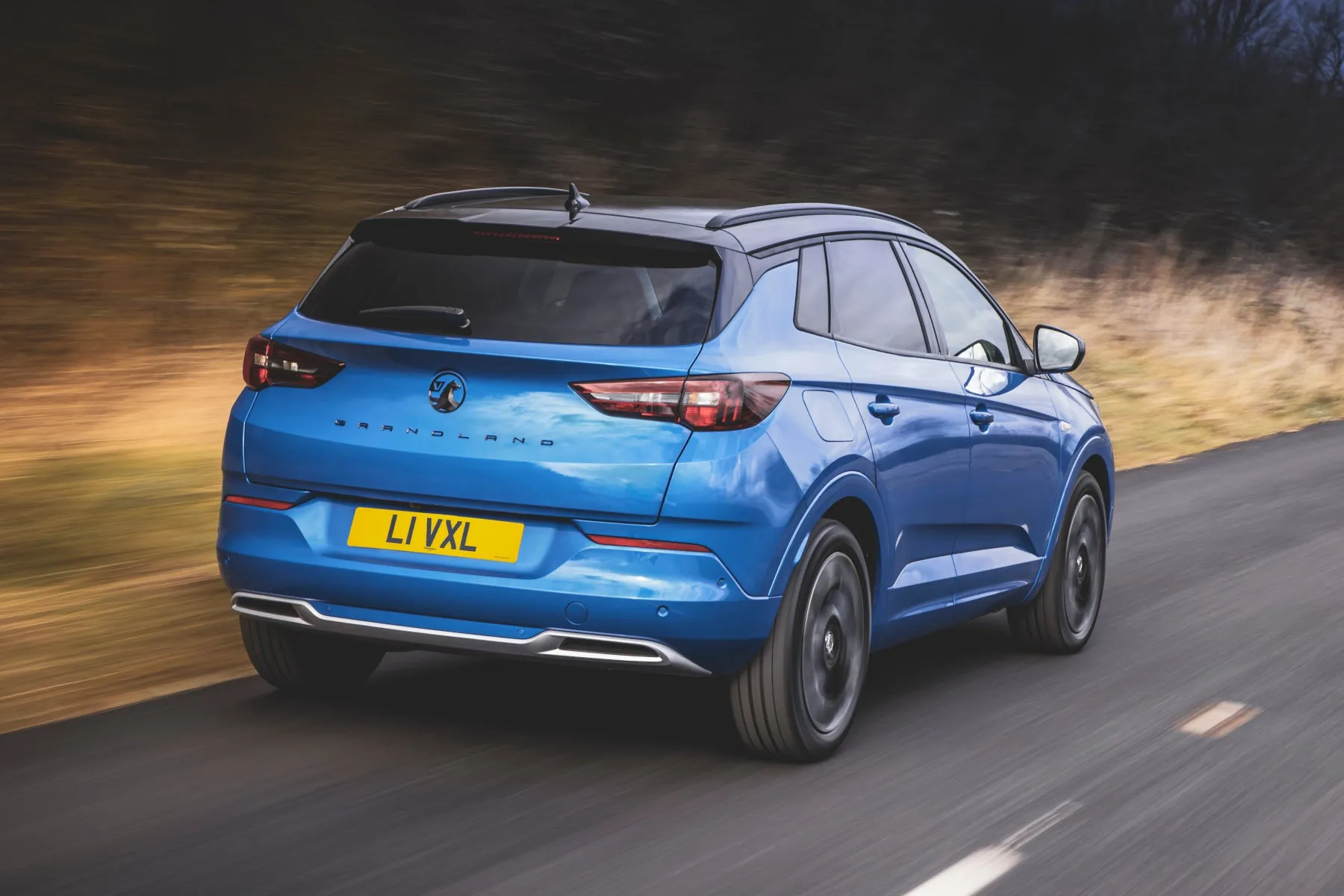
Will the new Vauxhall Grandland make the hairs on the back of your neck stand up with its emotive performance and thrill you in the bends? Well, no. It's a mainstream family SUV, what were you expecting?
The chassis and engines are largely unchanged after the Grandland's facelift. That means you get a pretty competent all-round SUV. It's not as engaging to hustle down a country lane as a SEAT Ateca or Mazda CX-5 , nor is it as wafty as its Citroen C5 Aircross cousin. It sits somewhere in the middle of the field, offering an agreeable and vice-free driving experience.
The base 1.2-litre turbo petrol is the lightest and keenest to change direction. The fairly light steering isn't brimming with feel, but it's confidence-inspiring enough and the Grandland doesn't feel out of its depth when pushing on. The brakes are a touch grabby at low speeds, though, while the manual gearshift isn't the most positive or slick around.
The suspension is clearly geared towards comfort, offering a pretty isolating ride that covers off the worst potholes in town. The larger 19-inch wheels of the Ultimate model introduce a bit more thumping at low speed, but it smooths out the faster you go, and all versions are comfortable on the motorway. That said, the relatively soft suspension means there's some pitch and roll if you take a corner too quickly.
The hybrid model's extra weight means it feels less nimble in quick driving, but when you're just mooching about (as most owners will be) it's competent enough, and the extra weight gives it a slightly more cosseting ride. The GSe version of the hybrid has revised suspension and feels a shade more nimble than the regular hybrid, but the weight management issues are still evident. At least the suspension revisions haven't harmed the ride comfort.
The light steering, and the fact that even the basic model comes with front- and rear parking sensors, means the Grandland is easy to squeeze into spaces. Mid-spec models get a 180-degree rear view camera, which upgrades to a 360-degree all-round view on Ultimate trim. The Grandland's raised ride height also makes it ideal for traversing nasty speed humps.
The old Grandland X had few semi-autonomous driver aids to speak of, but it's now greatly improved on that front, with top-spec Ultimate cars getting adaptive cruise control, lane positioning assist and (on automatic hybrid models) the Highway Integration Assist for stop-and-go traffic.
What engines and gearboxes are available in the Vauxhall Grandland?
You can have your Vauxhall Grandland with one petrol engine, one diesel engine or a pair of plug-in hybrids. An additional mild-hybrid powertrain joined the roster later on.
The 130PS 1.2-litre three-cylinder petrol engine may be the proverbial runt of the litter, but it never feels it. It accelerates the Vauxhall from 0-60mph in a 10.2 seconds, which doesn't sound great, but it feels faster than that, and it has enough mid-range surge to feel perfectly adequate in normal driving. It doesn't get obnoxiously noisy if you ask more of it, either, with a reasonably endearing thrum.
The six-speed manual gearbox is fine - not super slick or positive, but not soggy and imprecise either - which is good because steep hills on the motorway might require you to drop down a gear or two for overtakes, although the flip side of this is that the engine's barely ticking over at a cruise.
The hybrid (the non-plug-in one) combines this same engine with a 48-volt mild hybrid system that provides a small boost in power (136PS) and economy, but we haven't tried it yet.
We've not yet tried the now auto-only 130PS 1.5-litre four-cylinder diesel, either, which is a fair bit slower on paper than the petrol (0-60mph takes a yawning 12.3 seconds), but in the old Grandland X it was unwilling to rev and not particularly punchy. As a result, we'd advise you leave the diesel unless you do lots of motorway miles where you'll see the benefit of its improved fuel economy.
Or if you tow – the diesel will haul up to 1500kg compared to the 1400kg the petrol manages and the 1250kg the hybrids will shift.
The plug-in hybrid models, meanwhile, come into their own if you have a short enough commute to get in and out of work on battery power alone. With around 35 miles of electric range, that should be a decent chunk of motorists, although as always, the caveat is that if you're not able to plug it in at home or at work, it'll become expensive to run, and it's expensive to buy in the first place.
Both PHEVs use a 1.6-litre four-cylinder petrol engine. In the basic PHEV, 225PS is provided to the front wheels and the 0-62mph dash takes a surprisingly pedestrian 8.9 seconds. It still feels pretty punchy and delivers impressive economy while it juggles petrol and electric power sources. It'll also get up to 84mph in electric mode alone, although it takes a while to get there.
The GSe version has a more prodigious 300PS and four-wheel drive, and is a good bit faster, seeing off the 0-62mph sprint in 6.1 seconds. It's just about fast enough to be convincing as a performance SUV, but other such cars are faster still.
Refinement and noise levels
If you're look for a family SUV that's quiet, then the Vauxhall Grandland is one of the best. It will lollop along the motorway while barely breaking sweat – even the petrol is muted at a cruise – and there's not much wind noise to speak of save for a flutter around the wing mirrors. Tyre roar is also well contained except over poorly surfaced motorway sections, though for best results we'd avoid models with 19-inch wheels.
It's also a very quiet car in town, and that's especially true of the hybrid models, which can clear city centres and suburbs running on almost-silent electric power.
Safety equipment: How safe is the Vauxhall Grandland?
The old Vauxhall Grandland X scored five stars for safety when it was crash tested by Euro NCAP, although it's worth noting that this was achieved under 2017's less stringent test conditions.
Happily, the updated Grandland's increase in standard active safety kit should mean it's competitive with newer models in this area. Entry-level models now get autonomous emergency braking, speed sign recognition, a drowsiness alert and lane departure warning with lane keep assist.
Also standard across the range is cruise control with a speed limiter, auto-dip headlights and six airbags, while standard front-and rear parking sensors help you avoid low-speed shunts. Isofix mounts on the front passenger seat and outer rear seats are also standard.
Stepping further up the range to Ultimate trim gets you the lane position assistant (which subtly keeps you centred within your lane) as well as adaptive cruise control. The stop and go function only works on the plug-in hybrid model, however.
MPG and fuel costs: What does a Vauxhall Grandland cost to run?
"No Vauxhall Grandland costs a fortune to run for a mid-sized SUV, but the hybrid model is worth considering if it works for you "
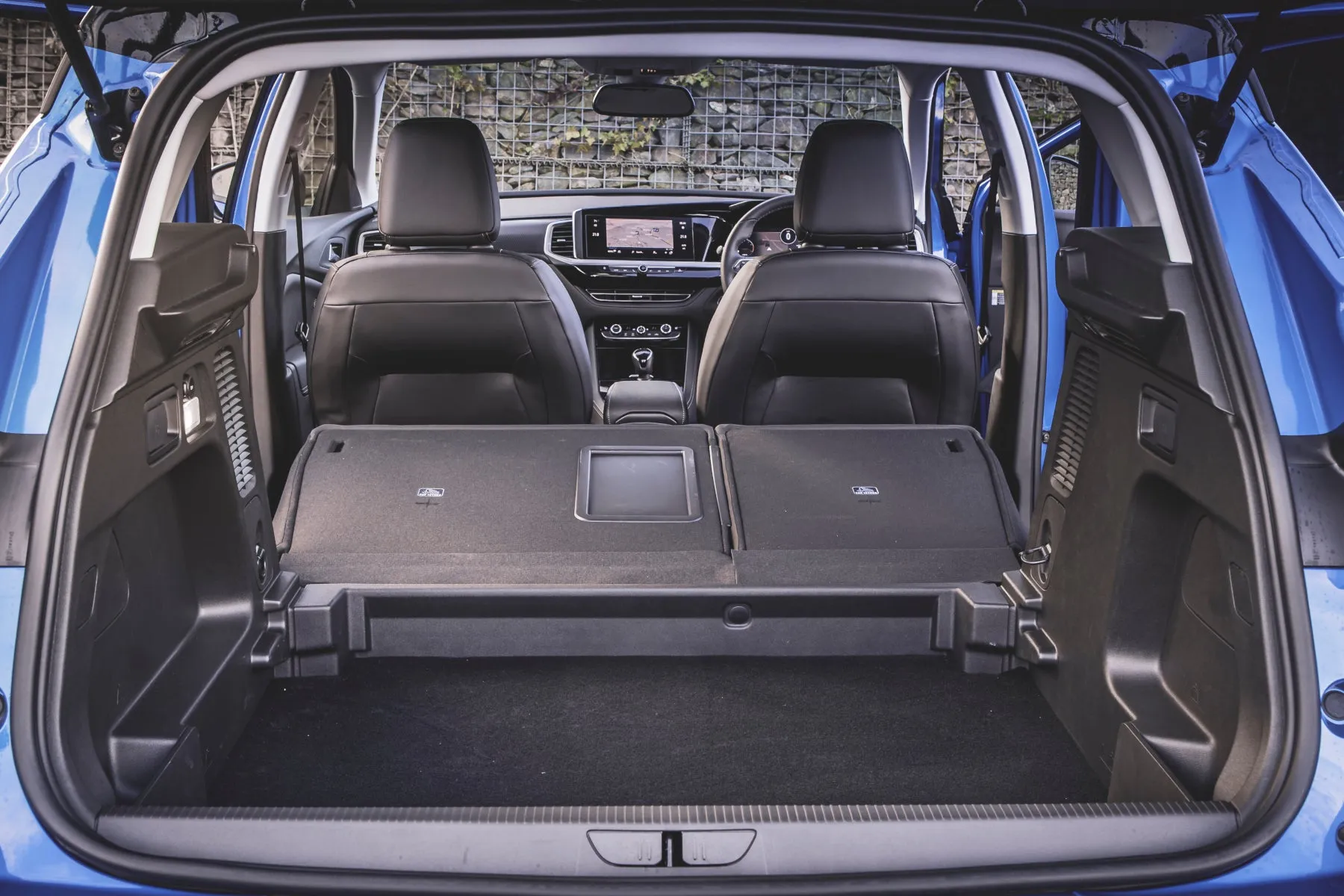
The model with the highest running costs on paper is the 130PS petrol, which will achieve up to 46mpg according to WLTP testing procedures. That drops a couple of MPG if you fit the optional automatic gearbox. The 130PS diesel model will get over 50mpg, and so will the mild hybrid, according to official figures.
The hybrid models can travel up to 36 miles on battery power alone and take as little as 1hr 45 min to recharge from flat using a 7.4kW wall charger. That requires an optional £500 6.6kW on-board charger, though: otherwise it's 3hrs 30 min via a wallbox, or 5hr 45 min via a three-pin socket. The PHEVs also have much lower benefit-in-kind tax rates than versions with a more conventional powertrain, making it the default choice for company car users, but with a 12% classification, many rival plug-in SUVs will cost less still in monthly company car tax bills.
Official fuel economy for the hybrids sits at upwards of 200mpg, which sounds extremely impressive. But regular charging is key, and the economy benefits are less obvious on longer journeys as, once the battery is drained, it uses more fuel than the standard petrol model. Blame the substantial weight of the battery for that.
How reliable is a Vauxhall Grandland?
Vauxhall doesn't enjoy the best reliability record, although that is partly because of the huge numbers of cars it sells. It's inevitable that some will go wrong, but it's probably fair to say that an equivalent Hyundai or Toyota will likely be more dependable.
The 1.2-litre petrol engine did have some early issues, while electrical gremlins aren't unheard of. As is often the case, it's worth avoiding the diesel unless you cover enough miles to keep the DPF (diesel particulate filter) clear of blockages.
Insurance groups and costs
Depending on trim level, insurance groupings for the 1.2 petrol version sit between 15 and 17, making it the cheapest version to cover. The diesel sits in groups 16 or 17, while for the mild hybrid, it's 18 or 19.
The lower-powered version of the plug-in hybrid sits between groups 23 and 25, while if you go for the full-fat GSe version, you'll pay a group 34 premium.
VED car tax: What is the annual road tax on a Vauxhall Grandland?
Go for the regular petrol or diesel model, and you'll pay the regular flat rate of tax, charged at £190 per year. Going for the mild hybrid or one of the plug-in hybrids will get you a discount, but since it's only a tenner per year, this shouldn't form a major part of your buying decision.
There's something else to bear in mind, too. Cars that cost over £40,000 (including any optional extras fitted) when new are subject to an additional surcharge of £390 per year on top, for a five-year period between years two and five of the car's life.
While early versions of the lower-powered plug-in hybrid fell below that threshold, adding a few options could tip it over, while periodic prices rises over time means that later examples will definitely be liable for the extra charge regardless of options. You'll also need to be careful with high-spec versions of the diesel and mild hybrid, as the prices of these also sailed dangerously close to the threshold. Whatever version you're after, it's worth doing an online check with the registration of any used example you're considering to make sure you know exactly what you're letting yourself in for.
How much should you be paying for a used Vauxhall Grandland?
"The Grandland is reasonably priced when new, starting from around £30,000. Stepping up through the trim and engine options will increase the price of your car pretty quickly, though. All plug-in hybrids will cost you upwards of £40,000, while the range-topping GSe costs more than £45,000."
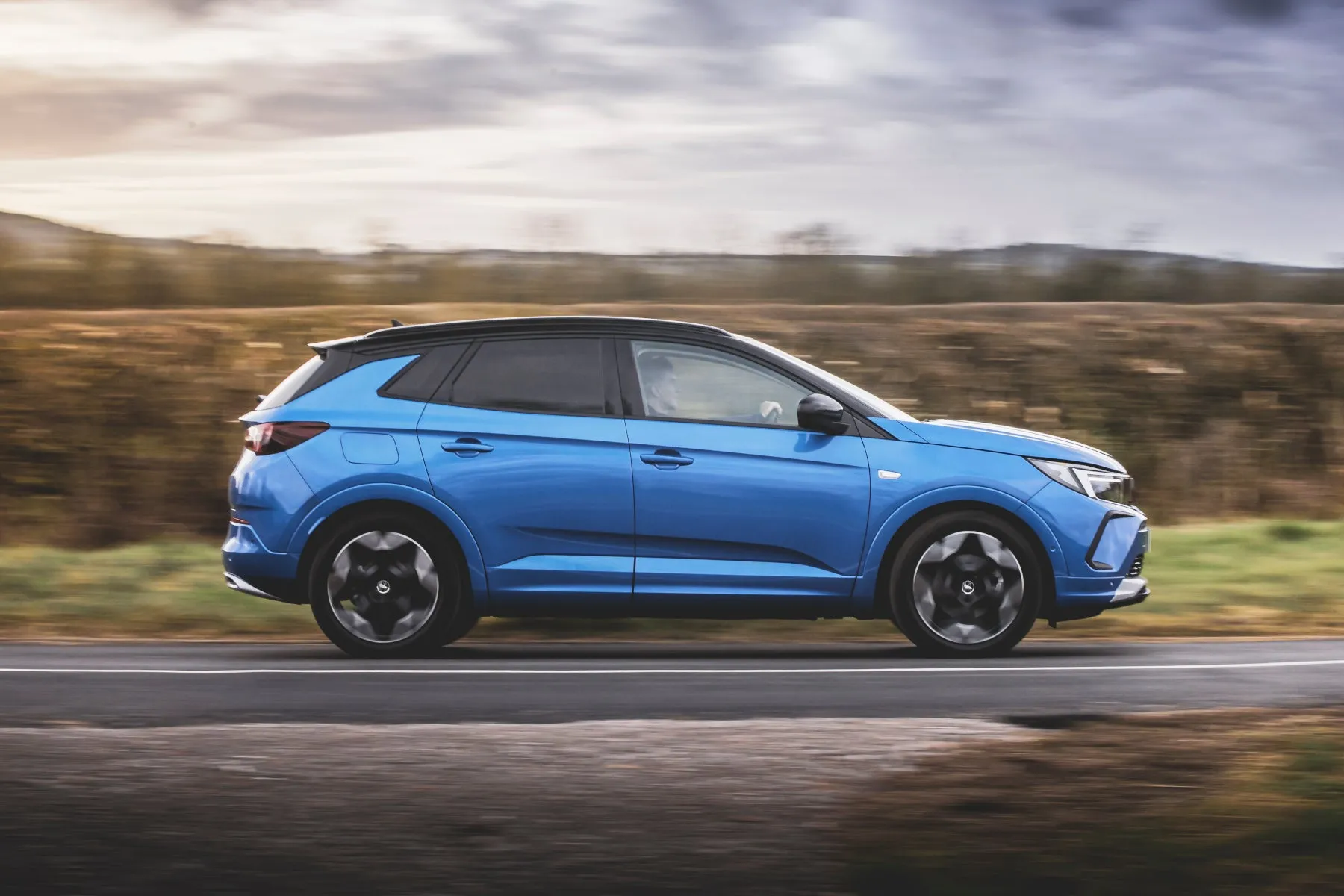
There are some very tempting savings to be made on the used car market, though. Browse our listings, and you'll find that £20,000 is enough to get you a two-year-old example with fewer than 20,000 miles on the clock, and there's lots of choice at this money. They're mainly 1.2 petrols in GS Line trim, but there's the odd plug-in hybrid with slightly higher mileage thrown in at this money, too.
Trim levels and standard equipment
Whereas the old Vauxhall Grandland X was available in no less than 13 trim levels (unlucky for some, particularly you if you have to make sense of them), the new car's range is much more simple. There's three trim levels, although the plug-in hybrid can't be had in entry-level Design trim.
Design spec has a (generally speaking) higher kit tally than the previous base model. It gets LED head and taillights with auto high beam, front- and rear parking sensors, a greater suite of driver assist tech (as detailed in the safety section) plus a 7.0-inch infotainment system with 7.0-inch digital dials. You also get 17-inch alloys and dual-zone climate control.
Step up to GS Line (later renamed GS) trim for 18in black wheels, black exterior detailing and gloss black roof rails, plus tinted windows (it's worth doing, as Design models look quite bland). You also get the upgraded 10.0-inch infotainment system with 12.0-inch digital dials, sat-nav, a rear view camera, uprated front seats and an anti-dazzle rear view mirror. Features specific to the hybrid model include the Vauxhall Connect subscription, thermal pre-conditioning and the Highway Integration Assistant.
Flagship Ultimate trim gets the IntelliLux adaptive LED headlights plus LED front fogs, a 360-degree parking camera, advanced park assist, adaptive cruise control, blind spot alert and keyless entry and start. There's also further upgraded front seats Alcantara trim and heating, a heated steering wheel and windscreen, an electric tailgate, a centre rear armrest and 19-inch diamond cut wheels.
Ask the heycar experts: common questions
Is the Vauxhall Grandland a good car?
Is the Vauxhall Grandland bigger than the Mokka?
Is the Vauxhall Grandland four-wheel drive?
Does the Vauxhall Grandland have a reversing camera?
Get our latest advice, news and offers
Keep me updated by email with the latest advice, news and offers from heycar.
By submitting you agree to our privacy policy
